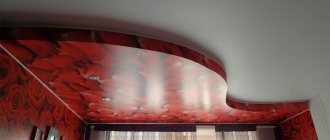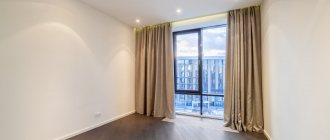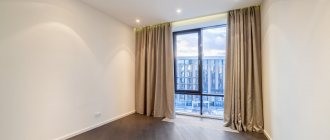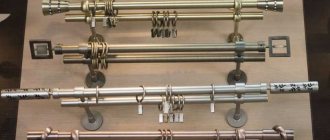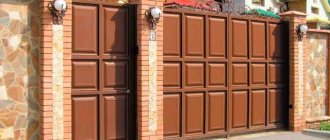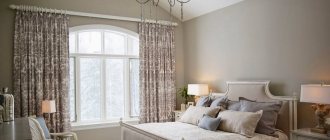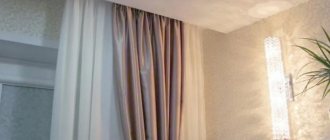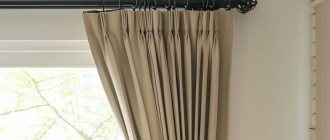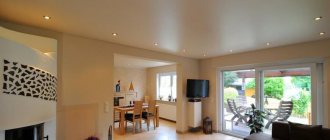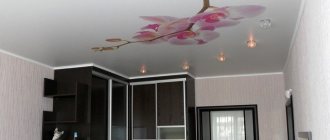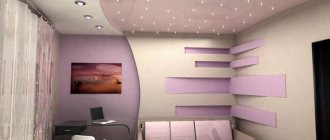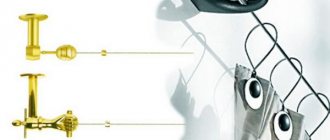One incorrectly selected detail can spoil the impression of the entire design canvas, created long and carefully. This applies to both works of art and home decoration. For example, to choose the right cornice for a suspended ceiling, photo examples from the Internet are not enough. You need to take into account your interior: the wallpaper pattern, the color scheme of the finish, and much more.
It is the harmonious combination of little things that gives the interior integrity, brightness and individuality. It is important to understand that there is no single correct answer to the question of what are the best options for attaching curtains in a room with suspended ceilings. Each time you have to solve the problem anew and with new input data.
In itself, a suspended ceiling is very practical: it is relatively inexpensive, varied in design, and easy to install. But the comparative pliability of the canvas causes some difficulties for designers - they have to somehow use more stable surfaces.
Read more: Is it worth hanging a suspended ceiling in the kitchen?
Types of curtain rods
When choosing, first of all, they focus on the type of mounting: ceiling or wall. The last option is always in sight, so you need to carefully select the cornice, taking into account the colors and style of the interior. But the product is easier to install - just screw it to the wall with self-tapping screws and dowels.
Installation of a wall cornice can be carried out both before and after the work on stretching the ceiling. But it is advisable to hang it when the repair is already completed. It is not always possible to accurately calculate how much the ceiling level will drop. And if the curtain rod is too high, protruding parts or rings can damage the canvas. And then you will have to repair or even change the entire surface.
Ceiling cornices cannot be hung directly on fabric or PVC film. These materials are not designed to withstand such a load, and therefore will stretch or tear.
To fasten the ceiling rail to the load-bearing ceiling, mortgages are screwed. This step is performed before the fabric is stretched. That is, a cornice for a suspended ceiling must be purchased in advance in order to know exactly the dimensions of the structure. When the canvas is stretched, holes are carefully made in it and the cornice is screwed to the mortgage.
Installation is more difficult, but the curtains start almost from the ceiling. The room appears higher because the wall is not divided by a crossbar.
There is another way in which the cornice on a stretch ceiling is not visible at all. To do this, leave a niche near the window in which the ceiling rail is attached. This way it is possible to hide the structure and create the effect of floating curtains. Installation is even more difficult, but in the future there will be no problems with changing the cornice.
In addition to the type of fastening, models differ in design, material, style, color, number of rows, etc. In another article, we have already examined in detail the types of curtain rods, we recommend reading them.
Features of installation with a suspended ceiling
To work you will need the following tools:
- drill or hammer drill;
- screwdriver;
- level;
- pencil;
- roulette.
Wall cornices
First you need to decide on the number of attachment points. They are located on both sides of the window. If the opening is large, additional supports will be needed every 1.5-2 meters.
The installation goes like this:
- Mark the mounting location on the wall.
- Using a level and tape measure, mark the remaining points at the same height.
- Drill holes and insert plastic dowels.
- Screw the cornice with self-tapping screws.
Ceiling tires
The first stage is marking. It is necessary to determine and mark where the cornice and attachment points will be located, as well as how far the ceiling will drop.
Tip: it’s convenient to start work when the frame for the stretch ceiling is already installed. When determining the height, they are guided by the baguette, since the support for the plank should be located on the same level as the canvas.
Then the installation of mortgages begins. For heavy models, it is better to use a wooden beam (the size of the cornice or slightly larger). For a lightweight ceiling bus, factory-made plastic platforms or homemade plywood analogues are suitable.
The beam must first be prepared:
- Saw along the length of the cornice.
- Sand to remove burrs and sharp corners that can damage the blade.
- Soak with antiseptic.
Then drill holes for fastenings and hammer dowels into them. If the rough ceiling is flat and the beam is wide enough, the beam is attached directly to the surface. In other cases, reinforced metal corners are used.
Mortgage platforms are installed only in places where the cornice is attached. Metal hangers are first screwed to them and then fixed to the ceiling.
It is important to ensure that the mortgages are positioned strictly horizontally. A level or a cord stretched between the baguettes will help with this. The second method is simpler and faster, and is not inferior in accuracy to a laser level.
Then the fabric is stretched. Holes are made at the required points. PVC film is pre-reinforced with thermal rings or aluminum tape to prevent the material from tearing. This is not required for fabric. At the final stage, the crossbar is screwed to the ceiling through the holes.
Selection of accessories
To decorate ceiling curtains, all kinds of accessories are used - tassels, eyelets, tiebacks, curtain holders and others.
When choosing these additions to curtains, you must follow certain rules:
No additional details can interfere with the overall design idea of the room;
- three-layer and two-layer compositions should not have many additional details;
- simple fabrics of not very bright colors require bright additional details.
By skillfully hanging curtains hidden under the ceiling, you can create a wonderful visual effect that transforms any room.
Such curtains create elegance and coziness in the interior, and for rooms with low ceilings, these curtains are undoubtedly the best option.
Which cornice is better to choose
To answer this question, you need to imagine:
- what kind of curtains will there be?
- fastening method;
- color scheme and general style of the apartment’s interior.
Curtains can be light and translucent or thick, heavy and do not allow light to pass through. For the former, plastic tires are sufficient; the latter will need more durable ones, metal or wooden.
The length is based on the size of the window or the entire wall. In the latter case, the curtains are opened as wide as possible, letting in more sunlight.
Cornices vary in the number of rows for curtains:
- Light curtains are most often hung in one;
- in two - tulle and thicker curtains;
- three - complex combinations with lambrequins.
The mounting method is chosen based on convenience and the desired impression. The main advantages of wall-mounted ones are ease of installation and ease of change. But the surface is visually divided by the crossbar. This option is more suitable for high rooms.
A more complex method is when the curtain on a suspended ceiling is attached through a mortgage. The advantage of this method is that the curtains start from the very top, so the room does not seem smaller. But there are also disadvantages. It is necessary to carefully select the cornice model, since replacement is technically quite difficult.
The hidden mount has the same disadvantage as the wall mount - it is not suitable for low rooms. There is another reason: the ceiling height is reduced by the size of the niche depth. But there are also advantages. A curtain falling from the very ceiling looks laconic and interesting.
In addition, you can install a built-in light in the pocket, which creates the effect of floating curtains. To do this, use an LED strip.
As for style, it doesn’t matter for the hidden fastening strip. In such cases, it is better to choose an inexpensive model with a simple design.
And with wall or open mounting, the cornice and suspended ceiling must be combined with each other and with the entire interior. The product complements and emphasizes the design. For modern styles, simple and elegant wooden or plastic crossbars, metal pipes, and combinations of materials are suitable. They are well compatible with glossy surfaces.
For a classic interior, imitation stucco (possibly with gilding) or carved wood is suitable. Forged products are appropriate in country or Provence.
Complex and effective cornices look good in a minimalist design. But if the interior is already overloaded with details, it is better to hang a simple bar.
It is important to consider the size of the room. In small rooms, it is advisable to limit yourself to modest, laconic cornices. And for a high hall, the crossbars can be wider and more elaborate.
Dimensions
A fairly wide range of sizes allows you to choose options for ceilings of any size, while the ceiling itself will remain without a joint.
The most popular plastic and aluminum models have similar dimensional characteristics. The length of a single profile reaches 4 m; longer or curly options are made from several elements. The width reaches 87 mm relative to the number of rows of fastenings.
The strip covering the curtain fastenings is 50 or 90 mm, while the one extended for blend patterns reaches 300 mm (quite rare custom-made models).
Wooden models are made to order, or can be purchased ready-made. The length of finished cornices is 200 cm, custom-made – up to 400 cm. There are no standard sizes for baguettes.
How to hide a curtain under a suspended ceiling
To prevent the cornice from being visible, a hidden niche is installed in front of the window. The dimensions are determined by the dimensions of the curtain, the width of the window sill and radiator, as well as ease of use (it is difficult to work with a tool in a too narrow space). Usually a width of 20-25 cm is sufficient. The length of the hidden pocket can be slightly larger than the window or occupy the entire wall.
To create an invisible niche, do this:
- Markings are applied.
- At a given distance from the window, a wooden beam is attached to the ceiling (the same as when installing mortgages).
- A frame is assembled from profiles (just below the edge of the beam).
- Stretch the fabric.
- Cover the cracks with decorative plugs.
After this, you can hang the cornice and curtains.
Features: A more durable metal profile BP-40 is sometimes used as a separator. This is more convenient, since the baguette already has space for attaching the canvas. You can also build a narrow plasterboard box.
Calculation of niche dimensions
The width of the structure (from the wall) is determined by adding the following parameters:
- Determine the amount of extension of the window sill or radiator (depending on what protrudes further from the plane of the wall). On average, the offset is within 15-18 cm.
- Measure the distance between the guides of the cornice if it is double-row. If there are more rows, take the distance between the outer guides.
- A correction is introduced into the calculations on the side of the curtain. The amendment (not to be confused with the assembly factor, which affects the number of folds) depends on the length of the cornice, and usually does not exceed 10-15 cm.
Curtains behind the ceiling cornice Source wp.com
Which curtains to choose for a stretch ceiling
The color of the curtains is selected taking into account the range of fabric, walls and furniture. Exact shade matching is not required. Dark curtains look better with a light stretch ceiling, pale curtains with a bright one. And the white surface does not go well with the same curtains.
Texture also matters. With glossy curtains, it is advisable to abandon luxurious heavy curtains and choose light, flowy curtains. Curtains with a pattern, pronounced texture and lambrequins are suitable for a matte ceiling, especially in calm tones.
There are stretch ceilings with photo printing, patterns or imitation of other materials (expensive fabrics, metal, stone). They are best combined with simple curtains.
With a “starry sky”, blackout curtains (lightproof) would be an excellent choice. This will make the shimmer and shine more pronounced.
General selection principles also work with stretch ceilings:
- Curtains should match the style of the entire interior.
- Curtains in dark colors or with a bright pattern visually bring the wall on which they are located closer. Knowing this effect, incorrect proportions can be improved.
- Vertical stripes increase the height, and horizontal stripes increase the width.
- In the kitchen, simple curtains are usually hung in one row.
- For a hall or living room, the design can be more magnificent; lambrequins, tassels and wide tiebacks look good.
- In children's rooms and bedrooms, it is better to combine translucent tulle with thick curtains that provide sufficient darkness for sleep.
Colors
In well-lit, bright rooms, light curtains are also necessary. Pastel-colored curtains, such as Japanese curtains, look great against a white ceiling fabric.
- Austrian curtains - the best models with interesting tailoring options in the interior + 150 photos
- Sheer curtains are an option that will help keep the interior light and cozy +140 photos
- Art curtains - 125 photos of modern curtains with exceptional interior design!
But we must refrain from combining the ceiling canvas with the same white walls, so that the room does not resemble a hospital.
It is better to hang curtains made of fabric that is not heavy at all to a glossy ceiling.
Bright, massive draperies in deep tones are hung with dark ceilings.
For a modern style, pleated or Roman curtains, which are now fashionable, would be very appropriate.
Curtains in the interior with a suspended ceiling
There are many varieties of curtain rods available depending on the type of fastening, material, size, etc. To create a harmonious interior, it is necessary to combine them not only with the color and texture of the fabric, but also with curtains. It is also important to take into account the general style orientation of the interior.
